Emperor Charles VI Signed Imperial Russian War Treaty Document Ottoman Empire RU
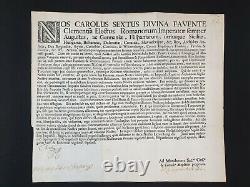
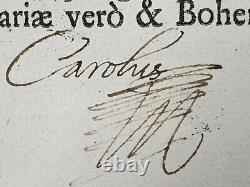
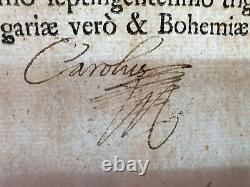
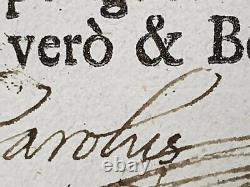
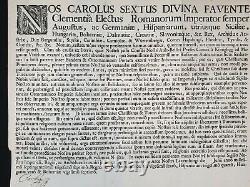
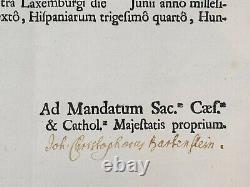
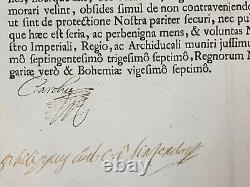
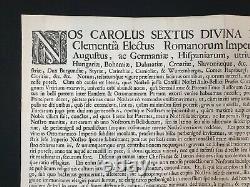
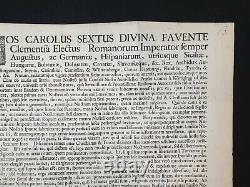
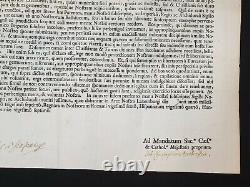
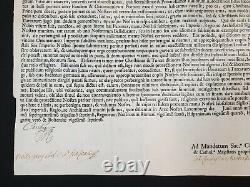


For your consideration is an exceedingly rare and historic hand-signed Royal manuscript document / edict / order / decree / commission / proclamation by Charles VI, Holy Roman Emperor of the Austrian Empire, announcing his alliance with Imperial Russia under Tsarina Empress Anna of Russia in their war with the Ottoman Empire in 1737. An absolutely amazing, original, one of a kind document of historic proportions! After the announcement, there follows an offer to peoples under Ottoman rule to surrender, and for those who want freedom from the Turks there is a description of privileges that will be granted to them i. Freedom from pillage and plunder by his army. The document is dated June 1737, with the space for the day of the month left blank. Charles VI (1 October 1685 - 20 October 1740) was the penultimate Habsburg sovereign of the Habsburg Empire. He succeeded his elder brother, Joseph I, as Holy Roman Emperor, King of Bohemia (Charles II), Hungary and Croatia (Charles III), Archduke of Austria, etc.
He unsuccessfully claimed the throne of Spain as Charles III following the death of its ruler, and Charles's relative, Charles II of Spain, in 1700. This is a particularly fine broadside, with woodcut initial and the signature of "Carolus VI" at the bottom left, with further undecipherable text underneath. Lower right has the signature of Johannes Christopherus Bartenstein.
Printed on thick, laid paper, folded; measures 36x41cm, or 14x16.25in. The war also represented Russia's continuing struggle for access to the Black Sea.Austria had been Russia's ally since 1726. The casus belli were the raids of the Crimean Tatars on Cossack Hetmanate (Ukraine) in the end of 1735 and the Crimean khan's military campaign in the Caucasus. In 1736, the Russian commanders envisioned the seizure of Azov and the Crimea.
In 1735, on the eve of the war, the Russians made peace with Persia, giving back all the remaining territory conquered during the Russo-Persian War (Treaty of Ganja). On 20 May 1736, the Russian Dnieper Army (62,000 men) under the command of Field Marshal Burkhard Christoph von Münnich took by storm the Crimean fortifications at Perekop and occupied Bakhchysarai on June 17. Crimean khans failed to defend their territory and repel the invasion, and in 1736, 1737 and 1738 Russian expeditionary armies broke through their defensive positions, pushing deep into the Crimean peninsula, driving the Tatar noblemen into the hills and forcing Khan Fet'ih Girey to take refuge at sea. They burned Gozlev, Karasubazar, the khan's palace in the Crimean capital, Bakhchysarai, and captured the Ottoman fortress at Azov.
Khans Kaplan Girey and Fat'ih Girey were deposed by the Ottoman sultan for their incompetence. However, 1737 to 1739 were notable plague years and all sides of the conflict were crippled by disease and unsanitary conditions.
Despite his success and a string of battlefield victories, the outbreak of an epidemic coupled with short supplies forced Münnich to retreat to Ukraine. On 19 June, the Russian Don Army (28,000 men) under the command of General Peter Lacy with the support from the Don Flotilla under the command of Vice Admiral Peter Bredahl seized the fortress of Azov. In July 1737, Münnich's army took by storm the Turkish fortress of Ochakov. Lacy's army (already 40,000 men strong) marched into the Crimea the same month and captured Karasubazar. However, Lacy and his troops had to leave the Crimea due to lack of supplies.
The Crimean campaign of 1736 ended in Russian withdrawal into Ukraine, after an estimated 30,000 losses, only 2,000 of which were lost to war-related causes and the rest to disease, hunger and famine. In July 1737, Austria entered the war against the Ottoman Empire, but was defeated a number of times, amongst others in the Battle of Banja Luka on 4 August 1737, Battle of Grocka at 18, 21-22 July 1739, and then lost Belgrade after an Ottoman siege from 18 July to September 1739. In August, Russia, Austria and Ottoman Empire began negotiations in Nemirov, which would turn out to be fruitless. There were no significant military operations in 1738. The Russian Army had to leave Ochakov and Kinburn due to the plague outbreak.
According to an Ottoman Muslim account of the war translated into English by C. Fraser, Bosnian Muslim women fought in battle since they "acquired the courage of heroes" against the Austrian Germans at the siege of Osterwitch-atyk (Östroviç-i âtik) fortress. Women also fought in the defense of the fortresses of Buzin (Büzin) and Chetin (Çetin). Their bravery was described in a French account, too.
Yeni Pazar, Izvornik, Gradiska, and Banaluka were also struck by the Austrians. In 1739, the Russian army, commanded by Field Marshal Münnich, crossed the Dnieper, defeated the Turks at Stavuchany and occupied the fortress of Khotin (August 19) and Iasi. However, Austria was defeated by the Turks at Grocka and signed a separate treaty in Belgrade with the Ottoman Empire on 21 August, probably being alarmed at the prospect of Russian military success. This, coupled with the imminent threat of a Swedish invasion, and Ottoman alliances with Prussia, Poland and Sweden, forced Russia to sign the Treaty of Nis with Turkey on 29 September, which ended the war. The peace treaty granted Azov to Russia and consolidated Russia's control over the Zaporizhia. For Austria, the war proved a stunning defeat. The Russian forces were much more successful on the field, but they lost tens of thousands to disease. The loss and desertion figures for the Ottomans are impossible to estimate. Charles VI German: Karl VI.Latin: Carolus VI; 1 October 1685 - 20 October 1740 succeeded his elder brother, Joseph I, as Holy Roman Emperor, King of Bohemia (as Charles II), King of Hungary and Croatia, Serbia and Archduke of Austria (as Charles III) in 1711. He unsuccessfully claimed the throne of Spain following the death of his relative, Charles II. In 1708, he married Elisabeth Christine of Brunswick-Wolfenbüttel, by whom he had his four children: Leopold Johann (who died in infancy), Maria Theresa (the last direct Habsburg sovereign), Maria Anna (Governess of the Austrian Netherlands), and Maria Amalia (who also died in infancy). Four years before the birth of Maria Theresa, faced with his lack of male heirs, Charles provided for a male-line succession failure with the Pragmatic Sanction of 1713. The Emperor favoured his own daughters over those of his elder brother and predecessor, Joseph I, in the succession, ignoring the decree he had signed during the reign of his father, Leopold I.
Charles sought the other European powers' approval. They demanded significant terms, among which were that Austria close the Ostend Company. In total, Great Britain, France, Saxony-Poland, the Dutch Republic, Spain, Venice, States of the Church, Prussia, Russia, Denmark, Savoy-Sardinia, Bavaria, and the Diet of the Holy Roman Empire recognised the sanction. France, Spain, Saxony-Poland, Bavaria and Prussia later reneged.
Charles died in 1740, sparking the War of the Austrian Succession, which plagued his successor, Maria Theresa, for eight years. Archduke Charles (baptized Carolus Franciscus Josephus Wenceslaus Balthasar Johannes Antonius Ignatius), the second son of the Emperor Leopold I and of his third wife, Princess Eleonor Magdalene of Neuburg, was born on 1 October 1685. His tutor was Anton Florian, Prince of Liechtenstein. Following the death of Charles II of Spain, in 1700, without any direct heir, Charles declared himself King of Spain-both were members of the House of Habsburg. The ensuing War of the Spanish Succession, which pitted France's candidate, Philip, Duke of Anjou, Louis XIV of France's grandson, against Austria's Charles, lasted for almost 14 years. The Kingdom of Portugal, Kingdom of England, Scotland, Ireland and the majority of the Holy Roman Empire endorsed Charles's candidature.Not wanting to see Austria and Spain in personal union again, the new Kingdom of Great Britain withdrew its support from the Austrian coalition, and the war culminated with the Treaties of Utrecht and Rastatt three years later. The former, ratified in 1713, recognised Philip as King of Spain; however, the Kingdom of Naples, the Duchy of Milan, the Austrian Netherlands and the Kingdom of Sardinia - all previously possessions of the Spanish-were ceded to Austria.
To prevent a union of Spain and France, Philip was forced to renounce his right to succeed his grandfather's throne. Charles was extremely discontented at the loss of Spain, and as a result, he mimicked the staid Spanish Habsburg court ceremonial, adopting the dress of a Spanish monarch, which, according to British historian Edward Crankshaw, consisted of "a black doublet and hose, black shoes and scarlet stockings". Charles's father and his advisors went about arranging a marriage for him. Their eyes fell upon Elisabeth Christine of Brunswick-Wolfenbüttel, the eldest child of Louis Rudolph, Duke of Brunswick-Wolfenbüttel. She was held to be strikingly beautiful by her contemporaries.
On 1 August 1708, in Barcelona, Charles married her by proxy. She gave him two daughters that survived to adulthood, Maria Theresa and Maria Anna. When Charles succeeded his brother in 1711, he was the last male Habsburg heir in the direct line. Since Habsburg possessions were subject to Salic law, barring women from inheriting in their own right, his own lack of a male heir meant they would be divided on his death. The Pragmatic Sanction of 19 April 1713 abolished male-only succession in all Habsburg realms and declared their lands indivisible, although Hungary only approved it in 1723.When Maria Theresa was born, he disinherited his nieces and the daughters of his elder brother Joseph, Maria Josepha and Maria Amalia. It was this act that undermined the chances of a smooth succession and obliged Charles to spend the rest of his reign seeking to ensure enforcement of the Sanction from other European powers.
Charles agreed to a demand from Britain that he close a trading company, (the Ostend Company), which was based in the Austrian Netherlands and that he himself founded in 1722. However, by 1735 he had secured approvals from key states, most importantly the Imperial Diet, which in theory bound all its members including Prussia and Bavaria. Other signatories included Britain, France, the Dutch Republic, Spain, Russia, Denmark and Savoy-Sardinia but subsequent events underlined Eugene of Savoy's comment that the best guarantee was a powerful army and full Treasury.
His nieces were married to the rulers of Saxony and Bavaria, both of whom ultimately refused to be bound by the decision of the Imperial Diet and despite publicly agreeing to the Pragmatic Sanction in 1735, France signed a secret treaty with Bavaria in 1738 promising to back the'just claims' of Charles Albert of Bavaria. This extended Austrian rule to the lower Danube. It too ended in an Austrian victory; by the Treaty of The Hague (1720), Charles swapped Sardinia, which went to the Duke of Savoy, Victor Amadeus, for Sicily, the largest island in the Mediterranean, which was harder to defend than Sardinia. [14] The treaty also recognised Philip V of Spain's younger son, Don Carlos (the future Charles III of Spain), as heir to the Duchy of Parma and Grand Duchy of Tuscany; Charles had previously endorsed the succession of the incumbent Grand Duke's daughter, Anna Maria Luisa, Electress Palatine.
Austria supported the former, France the latter; thus, a war broke out. The issue of Charles' elder daughter's marriage was raised early in her childhood. She was first betrothed to Léopold Clément of Lorraine, who was supposed to come to Vienna and meet Maria Theresa. Instead, he died of smallpox in 1723, which upset Maria Theresa.Léopold Clément's younger brother, Francis Stephen, then came to Vienna to replace him. Charles considered other possibilities (such as Don Carlos) before announcing the engagement to Francis. At the end of the War of the Polish Succession, France demanded that Francis surrender the Duchy of Lorraine (his hereditary domain), to Stanislaw Leszczynski, the deposed King of Poland, who would bequeath it to France at his death. Charles compelled Francis to renounce his rights to Lorraine and told him: No renunciation, no archduchess. Francis complied; he was married to Maria Theresa in February 1736, and Lorraine devolved to Stanislaw in July 1737.
In 1737, the Emperor embarked on another Turkish War in alliance with Russia. Unlike the previous Austro-Turkish War, it ended in a decisive Austrian defeat. Much of the territory gained in 1718 (Except for the Banat) was lost. Popular discontent at the costly war reigned in Vienna; Francis of Lorraine, Maria Theresa's husband, was dubbed a French spy by the Viennese.
The war not only revealed the sorry state of the Austrian army, but also the weakness of the imperial state itself, which did not have the financial strength to sustain a long war without the subsidies of its allies. At the time of Charles' death, the Habsburg lands were saturated in debt; the exchequer contained a mere 100,000 florins; and desertion was rife in Austria's sporadic army, spread across the Empire in small, ineffective barracks. Contemporaries expected that Austria-Hungary would wrench itself from the Habsburg yoke upon his death. Despite the predicaments faced by Charles, the territorial extent of his Habsburg lands was at its greatest since the days of his cognatic ancestor Emperor Charles V, reaching the Southern Mediterranean and including the Duchy of Milan.
The Emperor, after a hunting trip across the Hungarian border in "a typical day in the wettest and coldest October in memory", fell seriously ill at the Favorita Palace, Vienna, and he died on 20 October 1740 in the Hofburg. In his Memoirs Voltaire wrote that Charles' death was caused by consuming a meal of death cap mushrooms.Charles' life opus, the Pragmatic Sanction, was ultimately in vain. Maria Theresa was forced to resort to arms to defend her inheritance from the coalition of Prussia, Bavaria, France, Spain, Saxony and Poland-all party to the sanction-who assaulted the Austrian frontier weeks after her father's death. During the ensuing War of the Austrian Succession, Maria Theresa saved her crown and most of her territory but lost the mineral-rich Duchy of Silesia to Prussia and the Duchy of Parma to Spain. Emperor Charles VI has been the main motif of many collectors' coins and medals. One of the most recent samples is high value collectors' coin the Austrian Göttweig Abbey commemorative coin, minted on 11 October 2006.
His portrait can be seen in the foreground of the reverse of the coin.
